iOS 6 Review
Apple released iOS 6 for the iPhone, iPad and iPod touch this week, and while we've been using a beta version since June, now the final version is available to the public we can publish our full review.
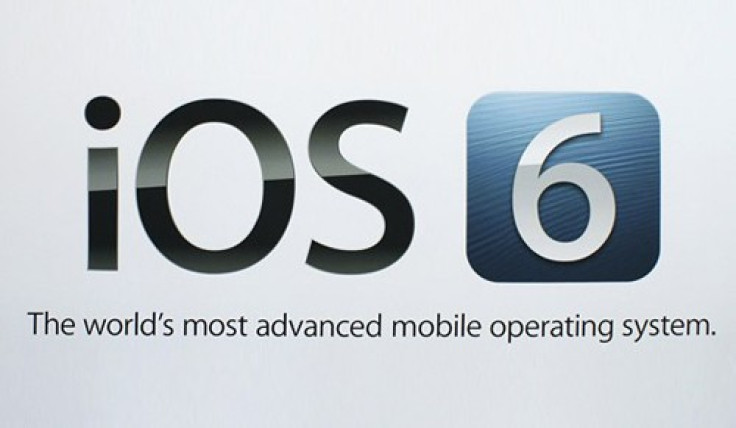
Key Features:
- Apple's own Maps app (no more Google)
- Siri improvements
- Passbook app
- Deep Facebook integration
- Cost: Free
iOS 6: Introduction
With iOS 6, Apple has added an all-new Maps application, ditching Google in favour of maps sourced from TomTom and others, along with a wide range of updates to Siri (now available for iPad, too), deeper Facebook integration and Passbook, the mobile wallet application.
However, one of the first things you need to know is whether or not iOS 6 will be available on your Apple devices. While not all features will work on all models, these devices will support iOS 6:
- iPhone 3GS
- iPhone 4
- iPhone 4S
- iPod touch 4th generation
- iPad 2
- The new iPad
Looking at device specific support for certain features, 3D maps and turn-by-turn navigation will be available on iPhone 4S and iPad 2 and the 3rd generation iPad only.
Siri will be available on iPhone 4S and the new 3rd generation iPad only.
Shared Photo Streams require iOS 6 on the iPhone 4 or later and iPad 2 or later, along with a Mac running OS X Mountain Lion.
FaceTime over 3G (or 4G where possible) requires iPhone 4S or 3rd generation iPad.
Offline Reading List in Safari works on the iPhone 4 or later and iPad 2 or later only.
iOS 6: Downloading and installing
Thanks to over-the-air updates, iOS can be downloaded and installed to your device without the need to connect to a computer or iTunes, but be warned - our iPad 3 required a massive 2.5GB of free space to install the 700MB update.
If you don't fancy deleting games and magazines to make space, then you'll need to plug into your computer and do the update over iTunes.
iOS 6: Maps
One of the biggest updates with iOS 6 is the new maps application - replacing the old version provided by Google with an app that uses mapping from sat nav maker TomTom, Apple and a range of other companies.
Parting from Google is a brave move for Apple, as this means that the app in iOS no longer has StreetView and the maps have already been criticised for lacking detail.
It gets worse; a search for the south Yorkshire town of Doncaster returned three results of companies in central London with Doncaster in the title - you have to already be looking at northern England before the search does what you asked.
When you find Doncaster, it's spelt wrong and you're greeted with "Duncaster".
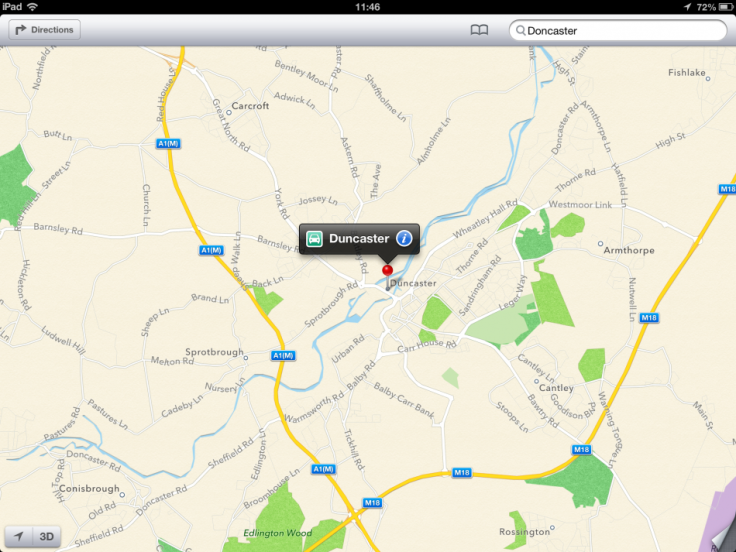
For comparison, doing the same search - while looking at a map of central London - in the recently updated maps app for Android (powered by Google, of course) provides the right town and correct spelling.
Searching for 'Westfield Stratford' returned a Vue cinema claiming to be at the Stratford shopping centre, but on closer inspection we found this cinema to be just off Oxford Street at the other end of London.
Again, Google Maps on Android had no trouble in finding what we were looking for with exactly the same search terms.
Another issue we've found is the inconsistency with satellite photography in Apple's maps app. Major towns and cities are covered in great detail, but more rural areas and even some smaller cities are not fully mapped yet.
We noticed it was particularly bad around York, where we counted five different qualities of image covering the city (see image below).
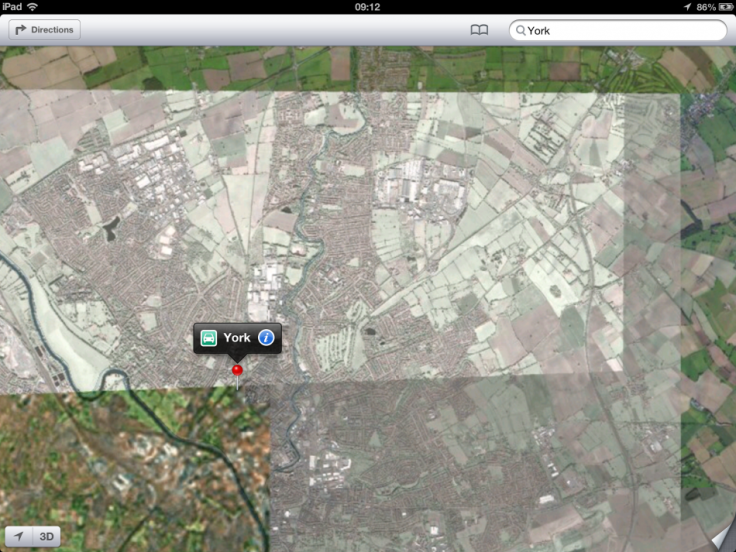
This isn't a loading problem, as we were using a Wi-Fi connection and waited more than a minute for the map to fully load.
Some areas are even in black and white, and others are so pixilated that individual buildings and even roads are impossible to make out - we found this to be the case in much of Wales.
Of course, we imagine Apple will improve its maps over time, but to roll out this half-finished and inaccurate application as part of a major iOS update is frankly embarrassing.
On the plus side, 3D maps look good once they are loaded up - but these are only available in major cities while the data is still being collected - and flying around central London, seeing the Shard, Parliament, Canary Wharf and the Olympic Park is fun.
Useful though? No, not really, and we wish Apple had spent more getting the basics right before working on the 3D images.
To its credit, Apple has given all iPhone, iPad and iPod touch users an app with free worldwide navigation and turn-by-turn directions spoken by Siri. We have not been able to use turn-by-turn much, but from what we've seen it works well and the signs are all very clear, updating quickly to any wrong turns you might make.

With turn-by-turn and 3D maps, Apple has the opportunity to provide a great maps application, but it needs to concentrate on getting the basics right and finished before adding anything else.
iOS Siri
With iOS 6 Apple has given Siri a major overhaul. The self-named humble personal assistant can now look up sports results, showing times at cinemas and help you book a table at a local restaurant.

Most important for users in the UK - and indeed anyone outside of the US - is that Siri can now search based on your location. "Where can I go for lunch?" now returns a list of local places to eat.
But it's not just food, as now Siri can find local businesses, take a photo and open any application on your device.
Siri has improved vastly since iOS 5 and even since the iOS 6 beta, where we found him/her to not understand our sports requests. Now though, it all works smoothly and adding the assistant to the iPad 2 and 3, iPod touch fourth generation and iPhone 4 is a good move by Apple to make owners of slightly older hardware to feel as included as those queueing up for the iPhone 5.
In a move that will see Apple take on Ford's SYNC in-car system developed in partnership with Microsoft, the iPhone manufacturer has teamed up with a range of car companies to adopt Siri integration.
BMW, General Motors, Toyota, Mercedes-Benz, Honda and Audi will be the first to work with Apple on Eyes Free, a method of controlling Siri from a steering wheel-mounted button and replying entirely with audio, rather than displaying anything on the iPhone's screen.
Eyes Free comes soon after a patent registered by Apple showing a system whereby the driver interacts with an iPhone or iPod using a steer wheel-mounted button - it seems that instead of being a click wheel as shown in the patent, Apple is looking to Siri for a more comprehensive in-car system.
Siri on the iPad is activated with a long press of the Home button and a list of possible questions is displayed the first time you open the assistant.
iOS 6 Facebook and Twitter integration
Deep Facebook integration makes its debut on iOS 6 and sits alongside Twitter integration introduced in iOS 5.
This all means that updating your social networks from pretty much anywhere in the operating system is a one-click affair.
Shortcuts to posting on social networks are located in the Notifications Center below the weather and stocks ticker.

Integration with Facebook and Twitter extends to your contacts, which can be synced with accounts to include their profile picture, birthday and a link to message them via Facebook in your address book.
Apple has revamped the sharing menu in iOS 6, where before a list of 'Add to Home Screen', Mail, Tweet and Print appeared when you wanted to share a link, now you're greeted with a screen of icons for Facebook and Twitter sharing, wireless printing, add to reading list and more.
This all means you can share a website link on Facebook and Twitter from within Safari, and add your location to that too if you so wish.
One implementation of this Facebook integration - which could be the most successful/annoying - will see people be able to 'Like' any app bought in the App Store or song or film purchased on iTunes. Expect your Facebook timelines to fill up with iOS 'Likes' soon.
While this may annoy some who constantly see Likes appearing on their news feeds, it will make apps and content more social and therefore more discoverable.
Apple and Facebook obviously believe that a recommendation from a friend is more valuable than a host of reviews from strangers, and they could be right.
Signing into Facebook and Twitter can be done in the Settings menu, or by installing the dedicated applications from the App Store and signing in to those.
iOS 6: Phone enhancements
With sat nav, cameras, Facebook and a personal assistant, it's sometimes easy to overlook some of the more basic features of our smartphones - like making and receiving calls.
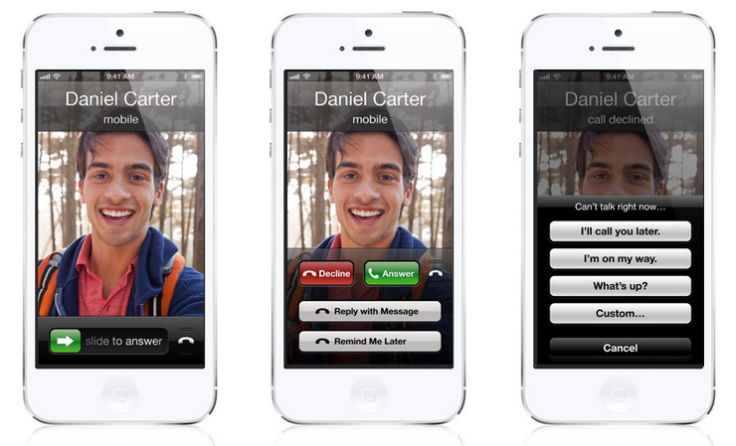
If a call comes through while you are already speaking to someone else, you can send one of several pre-written text messages to the caller - maybe one saying you're busy and will call back later.
Alternatively, you can reject the call, but set yourself a reminder to call them back in an hour.
We like these features and it goes to show that - dodgy maps aside - Apple is concentrating on the finer details to make iOS a more complete operating system, although remembering to use the new features when you're on the phone is another matter.
iOS 6: Passbook
A new native application for iOS 6, Passbook is "for the stuff in your pocket," according to the app itself; this includes plane boarding passes, tickets, store cards and coupons. Unfortunately, Passbook isn't yet active and does no more than show a landing page.
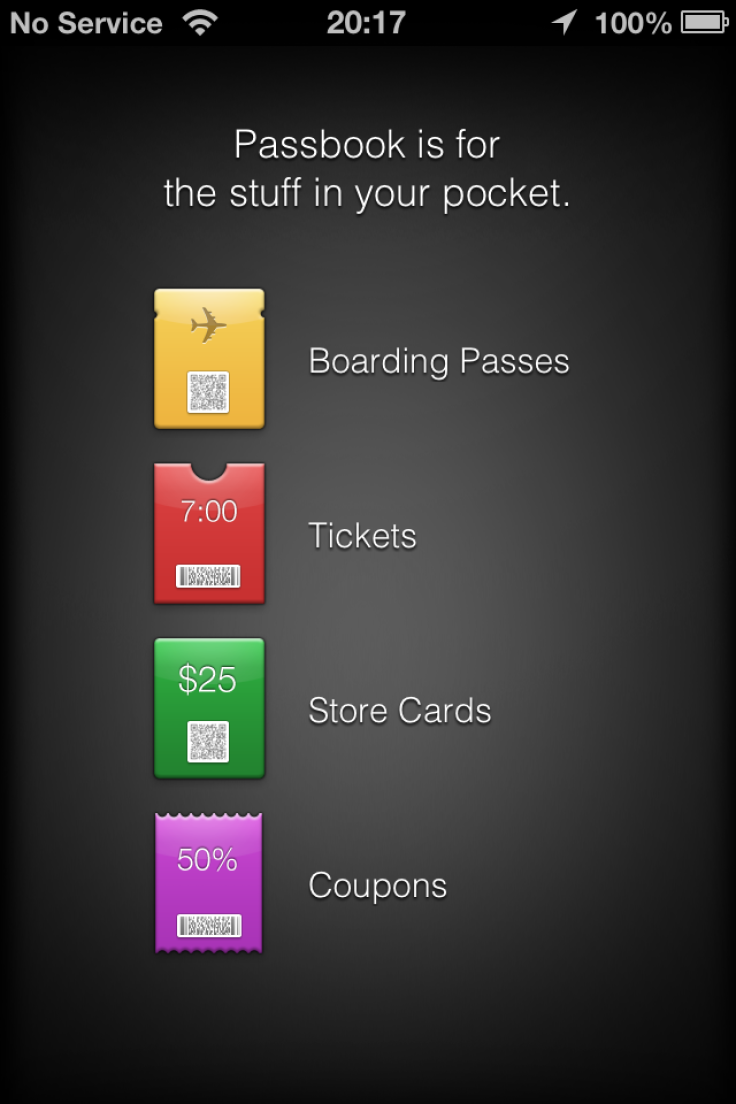
This will remain the case until retailers, gyms, travel companies and the like start to use the app and offer tickets and documents through it - something that we imagine will take some time.
Once up and running, however, Passbook will give a place to store digital copies of coupons and tickets, which appear on the screen as a code that can be scanned at the airport, cafe, shop or wherever.
You will be also able to store virtual loyalty cards in Passbook, which will certainly help remove a lot of bulk from your wallet or purse.
Passbook is also time- and location-based so it will, for example, move your plane ticket to the notifications on your lock screen on the day of your flight, and will even alert you if you're in the wrong terminal at the airport.
When Apple showed off Passbook earlier this year we were convinced that it would pave the way for the iPhone 5 to contain an NFC chip to use with the app.
But no, Apple sidestepped NFC completely and is continuing to put its substantial weight behind Passbook and it's alternative screen-scanning technology
Indeed, we thought that weight would have drawn in dozens of retailers ready to announce that they will be using Passbook now, but that wasn't the case and - for us in the UK at least - the app does little more than sit on our Home screen and tease us.
As with the maps app, Passbook feels distinctly unfinished.
iOS 6: Do Not Disturb
At last, a new feature iOS 6 that makes the update worth your time, especially if spam emails and drunken Facebook messages have a habit of waking you up at all hours.
Do Not Disturb is an option in the Settings app that lets you decide when during the day your iPhone will not respond to calls, texts or any other notifications.
For example, we set our iPhone to not be disturbed between 10:30pm and 6am, so any messages, emails etc received during those hours will still come through as usual, but the phone will not sound, vibrate, or light up the screen.
Exceptions can be made, however, so you can set the phone to ring if a certain contact or group of contacts tries to get in touch, and another option will cause the phone to ring only if the same number calls you twice in three minutes.
iOS 6: Clock app for iPad
For reasons only known to Apple, the iPad has never had a clock app, despite the iPhone and iPod touch offering a world clock, timer, alarm and stopwatch.
Thankfully, iOS 6 fixes this and gives the iPad a clock, offering everything the iPhone does and uses an updated design based on the Mondaine clocks as used by the Swiss rail system.
As with the iPhone version, multiple alarms can be set with the same range of alert sounds, and the stopwatch can record split times.
iOS 6: Safari
Apple has added three new features to the Safari web browser in iOS: iCloud Tabs, Offline Reading List and Full-screen landscape.
Open tabs can be synced across all your (Apple) devices in iOS 6, so if you're reading something on your Mac (using OS X Mountain Lion) and want to carry on later on your iPhone, opening Safari will reveal every tab that you had open earlier, thanks to keeping everything synced up with iCloud.
In iOS 5 Safari's reading list showed just a list of URLs that you could make a note of and read later. Sadly, the web pages themselves were not saved, making your reading list useless if you didn't have a signal.
Now though, adding a URL to your reading list saves the entire page, images and all, so everything in the list can be read offline - useful if you want to read web pages while travelling on the underground, for example.
Finally, there's now a full-screen mode in landscape for the iPhone and iPod touch. Rotate the device to landscape and tap the icon in the lower right corner to remove the toolbars and stretch the internet to fullscreen.
While browsing in fullscreen mode, the URL and search bars can still be accessed (although they disappear when you scroll down) and a pair of semi-transparent forward and back buttons appear in the lower left corner.
iOS 6: Panorama
The camera app has been given a small update with iOS, and along with a large shutter button there's a new panorama mode that lets you shoot 28-megapixel panoramic images. Simply hold your iPhone up (in portrait) and move the phone from left to right while the camera snaps away.
There are on-screen guides to help you keep all the images level and then iOS does a good job of stitching them all together into one very wide shot - perfect for capturing the horizon, for example.
The panorama features is not available on the iPad however, which we think is a good thing, as people take regular photos with Apple's tablet is ridiculous enough as it is.
iOS 6: FaceTime over 3G
Video calling between iOS devices and Macs made its debut last year with iOS 5, but the app could only be used over Wi-Fi. With iOS 6 Apple has opened up FaceTime so that it can be used over a 3G (or 4G) connection, meaning video calls can be made just about anywhere.
We're not sure how the network providers are going to react to those on unlimited data place being able to chew through hours of video calls each month at their expense, and we expect heavy users to use up their monthly data allowance quicker than usual.
Apple makes no mention of costs for 3G FaceTime, but does say: "Carrier data charges may apply. FaceTime is not available in all countries."
iOS 6: Shared Photo Streams
Adding an element of social networking to your pictures, iOS 6 lets you share photos with only the contacts you want, so images from a birthday party, for example, can be shared with just those who were there.
If those whom you have shared the photos with have a device running iOS 6 or a Mac with Mountain Lion then the shared photos will appear instantly in their Photos or iPhoto app, or on their Apple TV.
If they haven't got a compatible device, then shared photos can still be viewed on the web through a browser.
In another sign of the deep Facebook integration, shared photos can be liked by whoever they are shared with and comments can also be made.
iOS 6: Verdict
Apple's yearly iOS updates never fail to bring a wide range of new and exciting features, and we praise Apple for keeping older devices up-to-date longer than some competitors.
But iOS 6 has some major problems with its Maps app that need to be addressed - Google's Android maps are far superior, and Nokia's maps on its new Windows Phone 8 Lumia series look good, too.
After seeing it in June we had high hopes for Passbook, but with a complete lack of business partners to help get the system off the ground, it's going to be some time before our coupons, memberships and boarding passes are all stored in the app.
Elsewhere, the updates to Siri are very impressive - although we still wonder how many people actually use it - and adding the app to the iPad is a good move.
We like the new phone features and Do Not Disturb, as well as Panorama, but there isn't anything groundbreaking here, nothing to make Apple's rivals worry.
And that's the biggest point we can take away from this. While iOS 6 brings some 200 new features to many devices for free, the competition from Android and Windows Phone has closed up so much that it seems an average update simply won't cut it anymore.
From Apple we expect revolutionary every time, and while of course this cannot be achieved year in, year out, iOS 6 feels unfinished and we hope a 6.1 or even 6.5 update will fix much of the mapping problems.
© Copyright IBTimes 2024. All rights reserved.






